|
The journey into watercolor abstraction continued during Ruth Gilmore Lang's fall workshop. Unlike the previous painting (see Part 1), I wanted to pour all the colors concurrently, rather than wait between pours. In addition, Ruth encouraged me to go bigger yet. So out came a 32" x 40" aquaboard by Arches. That size is HUGE compared to my norm and comfort level!
I saved (mask) some whites. Then starting with premixed paint and a wet board, I began a semi-controlled pour of the paint - trying to react "intuitively" to the color choices, but consciously to it's placement. This layer, when dried, would become the underpainting (or background) of the painting. And so the semi-terrifying and adrenaline-rush pouring, tipping, hyper-ventilating blowing began. And then...I let it rest. The underpainting was done. And so was the workshop! Yikes, I had no idea where to go next besides home. Ruth - you can't leave me hanging like this.
0 Comments
It's been awhile. You may have read my long post from a few years ago when I plunged into abstract painting. Afterwards, how and what to paint got lost for a bit. That struggle continues even though I've continued to paint over these past years, exploring figure and portrait drawing, gouache, impressionism, figurative and abstract painting. But in all the experimentation, my devotion to watercolor has been resolute. This fall the opportunity to return to abstract painting arose. Ruth Gilmore Langs offered two 3-day workshops at her beautiful Jumping Water studio on the Huron River. And this time, I was ready to jump into that water to push myself and watercolors. My goal was to loosen up aided by two techniques: pouring watercolor, painting BIG (for me anyway). I also wanted to explore more if watercolor would be a good medium for creating abstracts. The first painting was done on a 30x20 Arches hot press art board. The first round was to wet an area of the paper and pour a primary color. Then add the next color and the next. This step left a lot of white where the paper hadn't been pre-wetted. This wasn't my intent. But I didn't mind the result. Never one to leave well enough alone, I decided to glaze in some yellow in one corner. Well then the rest of the painting looked out synch. Another round of pouring seemed needed to pull it back together. Reading more about pouring that night, I realized I should have wet the entire board before pouring. So this time I mixed up several shades of each primary, wet the board, and then tried a controlled pour so that red, blue and yellow would not mix all together and create mud. Hmm, Ruth couldn't watch after pouring the first red. But what the heck, I went for it, adding yellow and tipping and mixing, then the blues. More reds. Tip, blow, guide, pray. Let it rest. Wild, fun, creative. The inner kid turned loose. The inner Buddhist okay if it all went south. The beauty of watercolors having their own little party. And there it was - "Falling" - in love with painting and watercolor and even abstract painting.
Where do you go next after taking an abstract workshop that profoundly touches you, how you approach painting, and what you actually paint? Stuck. That's what I was after my last post on the Abstract Intensive (see below). Could I simply return to painting watercolor landscapes, flowers, buildings - business as usual - after pouring out my heart onto an abstract canvas? No. I stopped painting after the workshop. Stuck. Should I drop my watercolor style and take up abstract painting? At a crossroads. Two roads diverged in a wood...
And I - I asked for direction. I wrote Ruth Gilmore Langs, our abstract workshop instructor, and confessed I was at a loss for what and how to paint. Ruth's reply: "Start with what you know for sure :-)." Wise advice. But what did I know - for sure? Late that same afternoon, we were leaving a small country party store, CJ's, way out on North Territorial Road. We looked out across a frozen wheat field bordered by a row of leafless trees. And there was the most incredible sky, sunset. Stunning with its grey-blue streaks, red, orange and yellow glows silhouetting the lacy trees and grasses. And this is what I know, have known for a very long time: - I LOVE nature! - There is beauty all around ready to surprise, in the little rocks on the shore, the wind in the trees and the rising and setting of the sun. - Nature fills my heart, feeds my soul - when I look and when I listen - "my eyes of eyes open, my ears of ears awake". - I LOVE watercolors. - I may never be an abstract artist (but I'm not giving up just yet). - I will look to, listen to my heart when deciding what and how to paint. The workshop unforgettably instilled, reinforced this. So this weekend I picked up the brushes and watercolors again. Here is what my unstuck heart knows for sure: In the last post, "Pouring Watercolor...", I promised to retry the Andrews Bald Trail 1 painting by creating a color study (a smaller version than the original that plays with new color choices). The result is Andrews Bald Trail II (color study).
What Changed? Underpainting Wet-in-Wet vs. Pouring: When working on the color study this time, I opted not to pour watercolor for the underpainting, but instead painted it using wet-in-wet (applying fairly wet paint colors to wet paper). This allowed for a bit more control of the colors. Colors: I also limited my color palette a bit more than in the original painting. And instead of using Cobalt Blue, I switched to Ultramarine Blue (green shade) after reading an article in the most recent issue of Watercolor Magazine, "Getting to Know Blue" by Hazel Soan. For reds, only Alizarin Crimson; yellows: Aureolin Yellow and Winsor Lemon Yellow; greens: sap green, viridian mixed with either the yellows, blue or red. Foreground: Finally, with Pandora playing the Mozart station, I opted to use a much looser style and paint most of the foreground using the wet-in-wet approach. So the appearance of the retry is looser, softer edges, more impressionistic than realistic. Conclusions It was good advice to do a color study and retry the painting. It's also much more freeing for me to paint a bit looser, quicker (oh - and smaller). While I'm not sure the retry captures quite the feeling of the original photograph or my desire to create that peaceful, misty, mystical mood, it does have its own, "happy" feeling (ah, those primary colors do wonders). And...drum roll...I may try it once again...bigger. To pour or not to pour? I want to try it again, but probably not for this painting - it's cold out on the deck now! As always, it would be great to hear your thoughts. Happy Thanksgiving! Not all paintings are successes. I recently painted a small watercolor (see 'Stand Tall' in the gallery) using a new technique for me - pouring watercolor - to create a background or underpainting for the work. For a first attempt, it came out pretty well and was even accepted in to a juried show. Fired up by this experience, I was anxious to try painting bigger and experiment more with pouring watercolors. Since several folks asked how Stand Tall was painted, I thought it would be interesting to photograph the progress of the new painting. While the outcome of the new piece didn't quite capture the feeling, mood or look desired, it was a fun process. As my teacher, Nancy Solo, has said not all paintings are masterpieces. And you can always try again. So follow my process, check out lessons learned, and let me know what you think. Step 1 - Used structured painting approach (tips from artist Michael Konas) to plan the painting: Intention/Mood: Peaceful, quiet, mystical Focus/Design: Path weaving through the forest, mist/fog, light area by fallen log, tall, straight trees in the foreground Color Palette: Pine greens, oranges/yellows/browns of the fallen leaves and trees Underpainting: Aurolean Yellow, Quinacridone Red, Cobalt Blue Foreground Colors: Same as above, plus Burnt Umber, Burnt Siena, Alizarin Crimson, Lemon Yellow, Winsor Blue, Viridian, Winsor Green Step 2 - Drew the picture on Arches full sheet, 140 lb cold press paper (22 x 30). Then masked the areas to preserve the white (puddles, top of log, bits of sky, tips of leaves). Step 3 - Taped the paper edges to contain some of the paint during the upcoming pour. Step 4 - Poured the first layer: Yellow. I mixed my yellow in a small jar then put it on a plate. Working on the outside deck because of the potential mess, I first wet the paper in the areas where I wanted yellow, greens and oranges and then poured the yellow (upper left, upper middle, lower bottom). I picked up the paper to let the paint run and move in the desired areas. Then poured the excess paint back onto the plate. Despite the windy day, I left it outside to let the first layer dry. Step 5 - Poured layer 2: Blue. Same process as above. This time I poured the blue in the upper areas where I wanted sky and also greens (yellow and blue make green when using transparent watercolor). I also poured blue in the forest sections to help create the "dark" moody feeling that was coming later. Step 6 - Poured layer 3: Red. In the original photograph, the forest background seemed to have some red particularly on the right side. By pouring red over some of the blue to create violet, the impression of forest shadows might be achieved. Finally by combining the red with the yellow where the leaves appeared, I hoped to get a "glowing" underpainting for that section. Pouring Lessons Learned: Yikes - it's very hard to do a pour on such large paper. It runs and streaks and does what it wants. It's even more challenging to do it on a windy day. But it was a very good idea to do this outside. The paint does get all over including the backside of the paper. I battled taming the red for the remainder of the painting. I should have used the red more sparingly in the underpainting. Step 7 - Next up - paint the foreground - the forest, the leaves, rocks, logs and path. Try to capture the mist, the depth and feeling. But as noted earlier the pepto bismol red kept showing through. As I tried to neutralize it with viridian is just deepened. Adding blue to get more of a purple feel wasn't all that successful either. The painting seemed to become divided between the middle yellow light area and the reds of the forest. I kept pushing the painting to get a cohesive feel. I also worked to darken the foreground trees and soften the trees in the background. I removed the masking to reveal the whites and then softened those edges and worked on the path's puddles. But it just wasn't conveying the soft, misty feeling I was searching for. Figuring I had nothing left to lose, I tried glazing the forest with a light blue wash to unite it with the center area. But too many layers and colors - the dreaded mud, loss of translucency. Glazing also lost some of the saved whites, some of which I tried to recover using a scrubber and the handy Mr. Clean magic eraser. More Lessons Learned: Do a preliminary color sketch (thanks, Nancy). Limit the color palette and focus more on blues and greens in the forest to create the misty, peaceful feeling. Play more with how to achieve the mist. Keepers: I liked some of the path and log, trees.
Conclusions - It was a fun painting to attempt with a mix of ups and downs, challenges and thrills. Learned lots. Much like life, isn't it? But unlike much of life, there are do-overs. So yes, Nancy, I will try this painting, again. |
AuthorMary Murphy Archives
March 2019
Categories
All
|


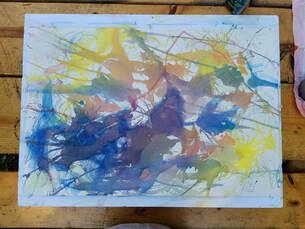

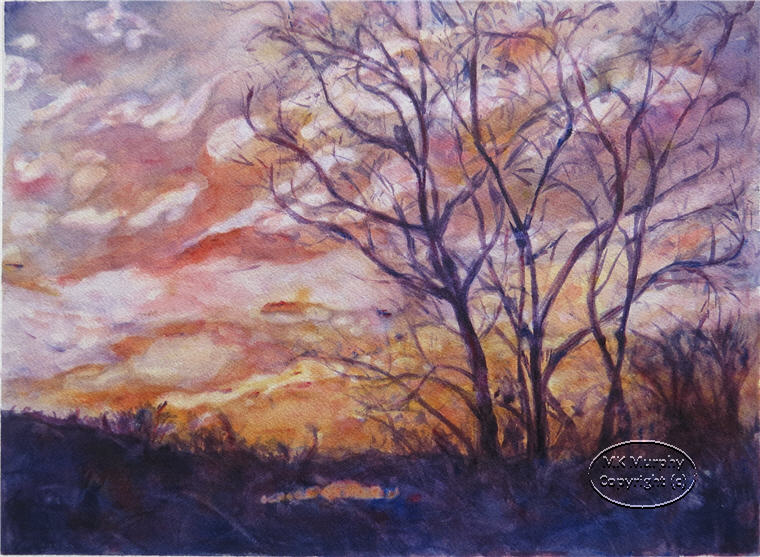
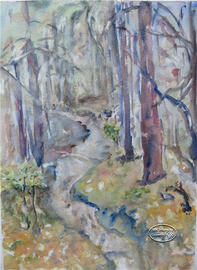




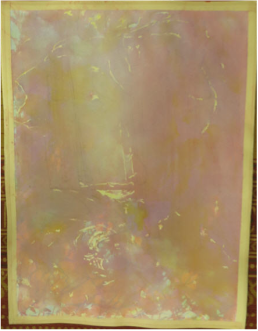

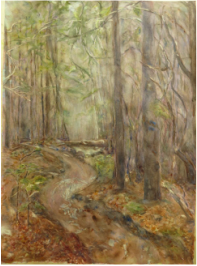

 RSS Feed
RSS Feed